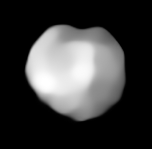89 Julia
Main-belt asteroid From Wikipedia, the free encyclopedia
89 Julia is a large main-belt asteroid that was discovered by French astronomer Édouard Stephan on 6 August 1866. This was first of his two asteroid discoveries; the other was 91 Aegina. 89 Julia is believed to be named after Saint Julia of Corsica. A stellar occultation by Julia was observed on 20 December 1985.
 VLT-SPHERE image of Julia. The large crater Nonza, half the diameter of the asteroid, is centered on the upper left quadrant. | |
| Discovery | |
|---|---|
| Discovered by | Édouard Stephan |
| Discovery date | 6 August 1866 |
| Designations | |
| (89) Julia | |
| Pronunciation | /ˈdʒuːliə/[1] |
Named after | Julia of Corsica |
| Main belt | |
| Adjectives | Julian /ˈdʒuːliən/ |
| Orbital characteristics[2] | |
| Epoch 31 July 2016 (JD 2457600.5) | |
| Uncertainty parameter 0 | |
| Observation arc | 149.68 yr (54672 d) |
| Aphelion | 3.0202 AU (451.82 Gm) |
| Perihelion | 2.08017 AU (311.189 Gm) |
| 2.55016 AU (381.499 Gm) | |
| Eccentricity | 0.18430 |
| 4.07 yr (1487.5 d) | |
| 255.367° | |
| 0° 14m 31.272s / day | |
| Inclination | 16.128° |
| 311.563° | |
| 45.461° | |
| Physical characteristics | |
| Dimensions | (89±2)×(80±1)×(62±3) km[3] |
| 140±3 km[3][4] 151±3 km[2] 148±8 km[5] | |
| Flattening | 0.30[a] |
| Mass | (4.3±3.2)×1018 kg[4] (4.3±3.6)×1018 kg[3] (6.7±1.8)×1018 kg[5] |
Mean density | 3.0±2.2 g/cm3[4] 3.0±2.6 g/cm3[3] 4.0±1.3 g/cm3[5] |
| 11.388336±0.000001 h (0.4745 day)[3] | |
| 0.216 (calculated)[4] 0.1764±0.007[2] 0.176 [6] | |
| S | |
| 8.74 to 12.61[7] | |
| 6.37[2] | |
| 0.18" to 0.052" | |
The spectrum of 89 Julia shows the signature of silicate rich minerals with possible indications of an abundant calcic clinopyroxene component. It is classified as an S-type asteroid. The asteroid has an estimated diameter of 151.4±3.1 km.[8] Photometry from the Oakley Observatory during 2006 produced a lightcurve that indicated a sidereal rotation period of 11.38±0.01 with an amplitude of 0.20±0.02 in magnitude.[9]
Nonza crater and Julian family
89 Julia is the parent body of the eponymous Julia family of asteroids. Observations of 89 Julia by the VLT's SPHERE instrument identified a 'highly probable' crater 70–80 km in diameter and 4.1±1.7 km deep in the southern hemisphere as the only visible possible source of the family.[10] The crater was named Nonza by the discoverers, referring to the commune on the island of Corsica where Saint Julia was born.[11] The excavated volume is on the order of 5,000 to 15000 km3. It is hypothesized an impact 30 to 120 million years ago by another body approximately 8 kilometers in diameter may have created the collisional family.
Notes
- Flattening derived from the maximum aspect ratio (c/a): , where (c/a) = 0.70±0.03.[4]
References
External links
Wikiwand - on
Seamless Wikipedia browsing. On steroids.

